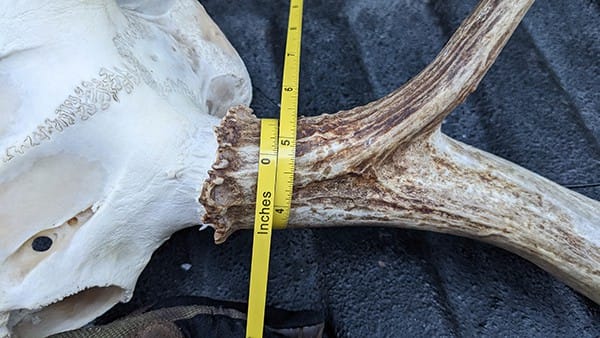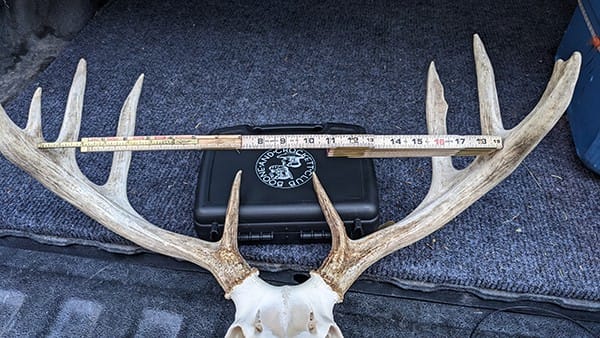 How to Score a Deer
How to Score a Deer
By PJ DelHomme
Scoring a deer’s antlers isn’t tricky, and it’s a great excuse to get together with your hunting buddies to relive good times afield. Here’s how you measure them.
The largest whitetail deer in the Boone and Crockett (B&C) Club’s record book was found dead along a road in Missouri in 1981. It scored more than 333 points. For over 100 years, B&C has kept records on North American big game species to gauge wildlife recovery efforts. They started keeping records in the late-1800s when wildlife populations were at an all-time low and refined their scoring system in 1950. We have healthier wildlife populations today, and their scoring system is still the gold standard.
When you kill a big whitetail on public land in Idaho or a cornfield in Iowa, someone will inevitably ask about the score. We all know hunting isn’t (or shouldn’t) be about what a buck scores, but the score provides a reference point. A buck scoring 120 points is a good deer for any hunter. You’re getting into record-book territory if you kill a buck that scores 160 points or more.
Gross vs. Net Score, Typical or Nontypical
Before you start adding up numbers, you need to decide on two things. First, is your deer typical or nontypical? If the rack has a lot of abnormal points, choose nontypical. Then download that score sheet here. Why does it matter? In the B&C scoring system, antler symmetry is rewarded. The closer the left antler matches the right, the fewer deductions your score will have because the differences in each side are deducted.
This leads to the second decision: gross or net score. The gross score adds up everything and deducts nothing. A net (or final) score will be lower than gross because there will be deductions for asymmetry—even for nontypicals. As you might imagine, some hunters scoff at net score because, as they say, “Nets are for fish. The deer grew it. You should count it.” But if you want to enter your buck into the B&C records, its rank will be determined by the net score.
Tools Needed
You can measure your deer with any flexible tape measure, but to get a more accurate score, here are a few items that will make the process much easier. The Boone and Crockett Club offers a Field Scoring Kit with all the tools you’ll need, but chances are, you have everything you need in your garage.

- Small tape measure (with 1/8” increments)
- Pencil
- Flexible steel cable or string
- White masking tape
- Carpenter’s ruler (optional)
- Score sheet (FREE download)
Five Steps to Scoring Your Deer
If you use the scoring sheet as your guide, you can fill in the measurements as you follow along below. Otherwise, just use a legal pad and add up the measurements.
1. Main Beam

The main beams branch from the top of the skull and wrap around to the front. They are the antlers from which all the other tines grow. To measure, place your string or steel cable at the base of the burr on the skull. Trace the length of the main beam with the cable. Be careful to hold the cable in place as you work around the beam. Once you reach the end, use some tape, an alligator clip, or a trusted friend to mark the end of the cable. Measure the length of the cable, and that’s one side of your main beam. Repeat on the other side.
2. Tines

Measuring tines accurately can be tricky. The key is finding the true base of each tine. To do that, place a piece of white masking tape at the bottom of each tine where it intersects the main beam. Then pretend that you’re going to saw off each tine to make the top of the main beam perfectly smooth. That’s the base of the tine, where you’ll make a mark with your pencil. From that line, use a tape measure or cable and measure to the end of the tip. Write it down. Note: G1 refers to the brow tine, G2 is the second tine, and so on.
3. Circumferences

These annoying little measurements measure a buck’s mass. There are four of them, and they are most easily taken with a tape measure. The first measurement is taken between the burr and the G1 (brow tine). The second measurement is taken between the G1 and G2, and so on. Circumference measurements are known as H1, H2, etc.
4. Inside Spread

Contrary to what the score sheet may have you believe, you’re not counting three spread measurements; the only one that matters is the inside spread. Greatest spread and tip-to-tip spread measurements are supplementary data measurements. If you’re not entering your deer into the record books, just worry about inside spread. A carpenter’s ruler is handy to get this measurement, but a tape measure works fine as well. The key to this measurement is to keep your ruler or tape perpendicular to the bases of the antlers. Measure from the middle of the main beam to the widest point. According to the official B&C measuring manual, the actual measurement will reflect the greatest distance between the inside edges of the two main beams at their center.
 5. Add (and Deduct)
5. Add (and Deduct)
If you use an official score sheet, follow the directions on adding (and subtracting) all those measurements. At first glance, it’s slightly less complicated than filling out your income taxes, but if you take it slow and stick to the basic measurements, you’ll get through it. You might need a seventh grader to help you with adding fractions; I did. If you forgo the score sheet, then simply add main beams lengths, tine lengths, circumferences, and inside spread. Your score might not be “official,” but it will be close enough for bragging rights.
*My best whitetail—the prop in the photos—did not make the minimum entry score for B&C.
PJ DelHomme writes and edits content from his home in western Montana. He runs Crazy Canyon Media and Crazy Canyon Journal.



